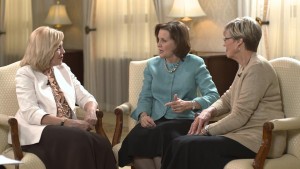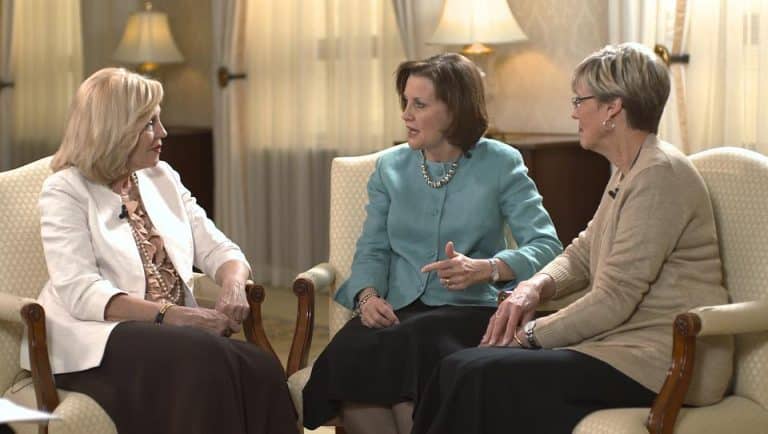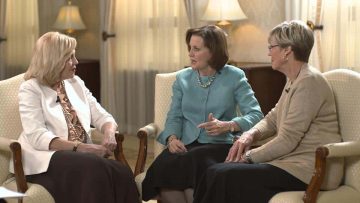 Mormon feminists have long advanced the notion that women should have the opportunity to offer feedback on policy decisions that affect women. Recent reports suggest that this message is being heard. However, an overemphasis on feedback, without female inclusion in other stages of the policy-making process, leaves much to be desired.
Mormon feminists have long advanced the notion that women should have the opportunity to offer feedback on policy decisions that affect women. Recent reports suggest that this message is being heard. However, an overemphasis on feedback, without female inclusion in other stages of the policy-making process, leaves much to be desired.
Recent examples of church policy-making suggest that there is more inclusion of women in churchwide policy-making today than there was in the nineties, when important initiatives such as the Proclamation on the Family and the Teachings of the Presidents of the Church curricula were advanced without female feedback. Reference D
Yet, a model in which feedback is the female role is still an androcentric model, with women excluded from both the beginning and end stages of the policy-making process. Certain women are offered opportunities to provide feedback after ideas are formed by men and before decisions are made by men but all of these women are selected by men through church callings or special invitation.
Brother Otterson’s account of his office’s discussions with feminists is particularly interesting to me, as a feminist who has unsuccessfully requested audience with general authorities to discuss women’s issues. Otterson reported that on at least one occasion years ago, church officials invited certain kinds of feminists to discussion groups but went on to say that as a rule, General Authorities and church employees “do not engage” with other kinds of feminists, thus limiting the potential for General Authorities to receive female feedback that does not conform with male preferences.
Whether there is space in the Church for women to advance their own ideas—instead of just giving feedback to men’s initiatives—is an open question. It is no secret that men, not women, make the decisions in our patriarchal church, but excluding female ideas is a more insidious form of sexism—albeit a likely result of a system in which several governing quorums and councils of the Church exclude women.
Examples
Changing Minimum Missionary Ages
“I’m especially thinking of one particular committee that you both were on with me [indicating Elaine S. Dalton and Rosemary M. Wixom] when we talked about changing the missionary age for the members of the Church, and that was a marvelous experience. At one point in that committee meeting, Elder Nelson stopped and said, ‘We don’t want to hear from anyone except the sisters,’ and then one by one he asked us our opinion: ‘How do you feel about this Sister Dalton? How do you feel about this, Sister Wixom? Sister Burton, what is your feeling? Tell us your honest opinion, and if you have concerns, we want to know.’ And we were very frank.” Linda K. Burton, General Relief Society President Reference A
Reversing the Ban on Mothers as Paid Institute and Seminary Teachers
“[Chad Webb, the administrator of LDS Seminaries and Institutes of Religion] said the adjustment has been considered for years now and was discussed with senior church leaders with responsibility for church education. He also asked for advice from the women who lead the church’s general auxiliary organizations. ‘We specifically sought their counsel and found that they were united in their feelings that this was the right thing to do,’ he said. ‘But ultimately this was an employment decision made by the Seminaries and Institutes Administration.’” Deseret News Reference B
Church Public Affairs Investigation of Feminist Concerns
“Some years ago Public Affairs invited three groups of women, all active Latter-day Saints and including feminists, to come for several hours each to discuss concerns. I use the term ‘feminist’ here not to imply political activism or campaigning, but simply as a term to describe those who want to further the interests of women in a variety of ways. The first two groups included single and married women, working mothers and stay-at home moms. Several in the groups had earned PhDs. The third group consisted mostly of members of stake Relief Society and Young Women’s presidencies, and we were particularly interested to learn if there were differences in perceptions between these groups. …We learned a lot, and those findings have long since been shared with members of the Twelve individually and in appropriate council settings.” Michael Otterson, Managing Director of Public Affairs for the LDS Church Reference C






16 Responses
April, I always enjoy your well-researched posts. Thank you for sharing here. It is certainly a step that the church appears to be consulting with women when contemplating changes in policy, but as you said, it still feels like women play a very passive and secondary role in this process.
Amen, April. Having women involved in the making of decisions is what we need, not having men make the decisions while women at best get to offer suggestions but have no actual decision-making authority.
I think President Burton’s framing of women’s input in your first block quote is so telling:
“At one point in that committee meeting, Elder Nelson stopped and said, ‘We don’t want to hear from anyone except the sisters,’”
Is this supposed to be comforting? This is implicitly a response to the charge that women never give any input ever. At *one* point, a man who was actually running the show asked women for their input? This is a level of input that’s so close to zero that they’re pretty much indistinguishable. But the charge isn’t that women are never consulted ever. It’s that they need to be completely integrated into the decision-making parts of the organization, not just consulted for feedback occasionally and then dismissed before the real decision-making happens.
Exactly! I think the rallying cry that some groups lobbying for the rights of disabled people is applicable here “Nothing about us, without us!”
[…] Mormon feminists have long advanced the notion that women should have the opportunity to offer feedback on policy decisions that …read more […]
Is Public Affairs still talking with varied groups of women? If this was useful years ago, is feedback still being sought this way?
Feedback is never an adequate substitute for input up front.
And certainly never a substitute for ACTUAL decision making power.
Agreed! But the statement made it sound like Public Affairs had done this years ago and then figured it was done for all time.
Why are they addressed as Sister Wixom, Sister Dalton, and Sister Burton? Why is the female president of an all-female organization excluding Primary] neither referred to as ‘President,’ nor allowed to, you know, preside? The Women’s Broadcast is now at least a session of conference (thanks DFU!) but it’s still presided over by a man.
April knocks it out of the park – again!
And lest we forget, any requests to be included or considered must be made in the ‘proper tone’. I often feel like Oliver Twist when having to interact with Priesthood authorities with oversight over the leadership callings I’ve served in. “Please, sir, I want some more.”
Amen, April.
I think the distinction between feedback and actual participation in creation of policy and direction is an important one and applies to more than just feminists, and I appreciate you using these examples, April,because it does show that the Church is trying.
This discussion, I believe,can be expanded to all marginalized groups in the Church…feminists, people of color, members of the LGBTQIA* community, and even white Mormon males who don’t fit the leadership mold in terms of belief or appearance.
When we keep the leadership, i.e. those who are creating programs and policies that best build and spread the Gospel of Jesus Christ, homogeneous, we do not have all of the parts of the body of Christ building the Kingdom. Our kingdom cannot be whole.
[…] are still only operating with the ability to provide feedback, and as April recently pointed out, feedback is not enough. But since we have a currency, we often feel that what we have is enough, particularly because we […]
[…] men meet alone and solicit female feedback only when they happen to realize that it is needed. Feedback is not enough because it excludes women from bringing in ideas at the beginning of the process and participating […]